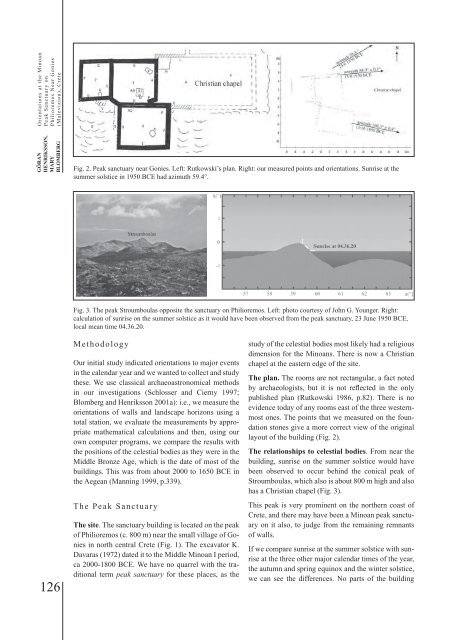BALTICA10
BALTICA10
BALTICA10
Create successful ePaper yourself
Turn your PDF publications into a flip-book with our unique Google optimized e-Paper software.
Orientations at the Minoan<br />
Peak Sanctuary on<br />
Philioremos Near Gonies<br />
(Maleviziou), Crete<br />
GÖRAN<br />
HENRIKSSON,<br />
MARY<br />
BLOMBERG<br />
Fig. 2. Peak sanctuary near Gonies. Left: Rutkowski’s plan. Right: our measured points and orientations. Sunrise at the<br />
summer solstice in 1950 BCE had azimuth 59.4°.<br />
Fig. 3. The peak Stroumboulas opposite the sanctuary on Philioremos. Left: photo courtesy of John G. Younger. Right:<br />
calculation of sunrise on the summer solstice as it would have been observed from the peak sanctuary, 23 June 1950 BCE,<br />
local mean time 04.36.20.<br />
126<br />
Methodology<br />
Our initial study indicated orientations to major events<br />
in the calendar year and we wanted to collect and study<br />
these. We use classical archaeoastronomical methods<br />
in our investigations (Schlosser and Cierny 1997;<br />
Blomberg and Henriksson 2001a): i.e., we measure the<br />
orientations of walls and landscape horizons using a<br />
total station, we evaluate the measurements by appropriate<br />
mathematical calculations and then, using our<br />
own computer programs, we compare the results with<br />
the positions of the celestial bodies as they were in the<br />
Middle Bronze Age, which is the date of most of the<br />
buildings. This was from about 2000 to 1650 BCE in<br />
the Aegean (Manning 1999, p.339).<br />
The Peak Sanctuary<br />
The site. The sanctuary building is located on the peak<br />
of Philioremos (c. 800 m) near the small village of Gonies<br />
in north central Crete (Fig. 1). The excavator K.<br />
Davaras (1972) dated it to the Middle Minoan I period,<br />
ca 2000-1800 BCE. We have no quarrel with the traditional<br />
term peak sanctuary for these places, as the<br />
study of the celestial bodies most likely had a religious<br />
dimension for the Minoans. There is now a Christian<br />
chapel at the eastern edge of the site.<br />
The plan. The rooms are not rectangular, a fact noted<br />
by archaeologists, but it is not reflected in the only<br />
published plan (Rutkowski 1986, p.82). There is no<br />
evidence today of any rooms east of the three westernmost<br />
ones. The points that we measured on the foundation<br />
stones give a more correct view of the original<br />
layout of the building (Fig. 2).<br />
The relationships to celestial bodies. From near the<br />
building, sunrise on the summer solstice would have<br />
been observed to occur behind the conical peak of<br />
Stroumboulas, which also is about 800 m high and also<br />
has a Christian chapel (Fig. 3).<br />
This peak is very prominent on the northern coast of<br />
Crete, and there may have been a Minoan peak sanctuary<br />
on it also, to judge from the remaining remnants<br />
of walls.<br />
If we compare sunrise at the summer solstice with sunrise<br />
at the three other major calendar times of the year,<br />
the autumn and spring equinox and the winter solstice,<br />
we can see the differences. No parts of the building
















